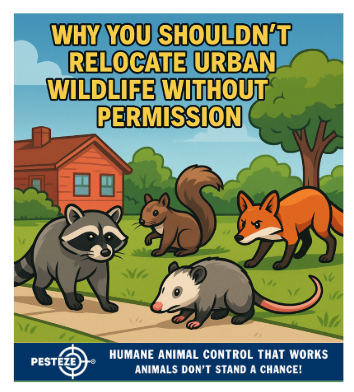WHY YOU SHOULDN’T RELOCATE URBAN WILDLIFE WITHOUT PERMISSION

WHY YOU SHOULDN’T RELOCATE URBAN WILDLIFE WITHOUT PERMISSION
SUMMARY
Relocating urban wildlife may seem like a compassionate solution, but it can harm animals, disrupt ecosystems, and even violate local laws. This guide explains the risks of unpermitted wildlife relocation, safe alternatives, and why professional assistance is essential.
FEATURES
-
Legal restrictions: Many regions have strict laws about trapping and relocating wildlife.
-
Animal welfare concerns: Relocated animals may struggle to survive in unfamiliar areas.
-
Spread of disease: Relocation can transfer parasites or pathogens to new environments.
-
Ecological disruption: Moving wildlife can upset local food chains and habitats.
-
Risk to humans and pets: Handling wildlife without training increases the chance of bites or scratches.
-
Better alternatives exist: Exclusion, deterrents, and professional control are safer solutions.
GUIDE DESCRIPTION
Encountering wildlife in urban settings is increasingly common as animals adapt to city life. From raccoons and opossums to squirrels and foxes, many species thrive in neighborhoods due to easy access to food and shelter. While it may be tempting to trap and relocate these animals, doing so without permission is not only unsafe but also potentially illegal.
One of the most important reasons is legal restrictions. Many states and municipalities prohibit or tightly regulate the relocation of wildlife. This is because relocation can spread disease, stress the animal, or lead to ecological problems. Attempting to move an animal without proper authorization could result in fines or legal consequences.
Beyond legality, there are serious animal welfare concerns. Relocated wildlife often struggles in unfamiliar environments. Animals may have difficulty finding food, water, or shelter and may be attacked by resident wildlife defending their territory. Studies show that many relocated animals do not survive for long, making relocation more harmful than helpful.
Relocation can also contribute to the spread of disease. Animals often carry parasites like ticks and fleas or pathogens like rabies and leptospirosis. Moving them introduces these risks to new regions, endangering both other animals and people.
The practice also causes ecological disruption. Wildlife populations are carefully balanced by local food chains. Introducing new individuals into an area can increase competition for resources, disrupt predator-prey relationships, or cause overpopulation. Even seemingly small relocations can have far-reaching environmental effects.
Additionally, there is a risk to humans and pets. Handling wild animals without proper training or equipment can result in scratches, bites, or exposure to diseases. This makes DIY relocation especially unsafe for homeowners.
Fortunately, there are better alternatives to relocation. Humane exclusion techniques, such as sealing entry points, using motion-activated deterrents, and removing attractants, prevent wildlife from becoming long-term residents on your property. In cases where an animal is trapped indoors or causing damage, professional wildlife control services are the safest and most effective option. They follow local regulations and ensure that animals are handled ethically.
By avoiding unauthorized relocation, you protect wildlife, your community, and yourself. Education and prevention are key to coexisting safely with urban animals.
- Saneeth Thota


Comments 0